Original 52 sq/ft Chapelle Sail Plan
Astute observers and Melonseed owners will have realized I made too many spars. And there’s nothing called a “yard” on a traditional Melonseed. But once again I’ve done my best to channel Robb White, and in choosing a sail plan have gone somewhat against the grain and conventional wisdom. I used historic precedents, though, and the risks here are not as great as with the unconventional centerboard design.
Several sail plans have already been developed for the Melonseed, and I’ve considered the merits of them all. Each have their advantages. The original 1888 plans, designed for maximum safety under dangerous winter conditions, were quite small by today’s standards. Chapelle’s plans show a 52 sq/ft sail, with mast and spars short enough to fit in through the smaller, more enclosed cockpit and stow inside the boat. The ability to stow a rig completely is not just a convenience for storage; it’s particularly valuable on small boats intended for long distance travel on the water. Without engines, if caught out a long way from shore in little wind, it might be necessary to row for many miles to get home. It’s useful, too, in a severe squall, when the whole rig can come down and you can fight it out more safely using oars with no risk of capsize.
In a pleasure boat, though, we rarely sail in winter, and a capsize in warm water is not nearly so dangerous. We also have more flexibility in terms of the kinds of conditions we sail in, as well as far better weather forecasts than they had in the 1800’s. Barto’s updated plans call for a 72 sq/ft sail, also sprit rigged with a boom. To achieve this he uses much longer mast and spars. The only downside is even with an enlarged cockpit the rig won’t fit inside the boat. Most people build a rack to hold them during transport, and will use a brailing line to fold up the rig for rowing. It makes a nice big sail, and usually incorporates some way to reef.
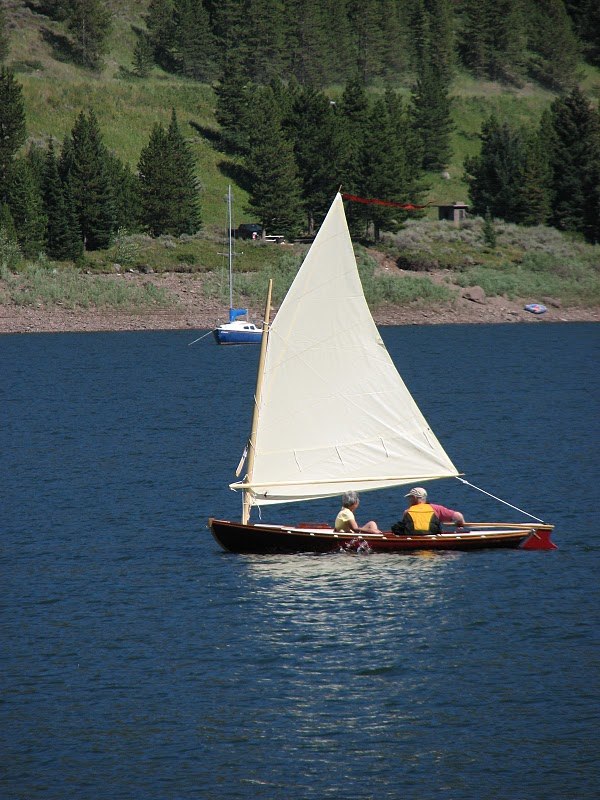 The Thatchers maiden voyage with the Barto rig.
The Thatchers maiden voyage with the Barto rig.
Tony modified the plan to use a sprit boom. (Tony’s photo)
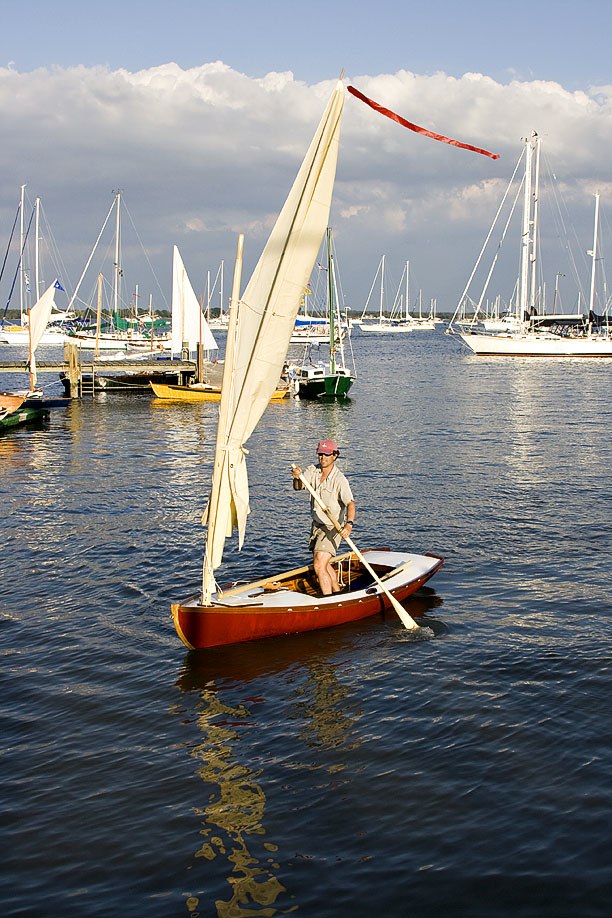 Tony paddling in at St. Michaels, with the sail brailed up.
Tony paddling in at St. Michaels, with the sail brailed up.
Roger Crawford designed something in between. His boats have a more modest 62 sq/ft sail than Barto’s, with a sprit and a sprit boom, which makes them very simple to rig and sail. The smaller sails, though larger than Chapelle’s original, can handle an incredible amount of wind without reefing – in fact, they have no reefs. With an enlarged cockpit, the 10 foot sprits and mast will still stow inside the boat. This balance of safety and simplicity achieves exactly the goals Crawford adheres to with his boats. The tradeoff is the sail can seem a little too modest for more adventurous sailors in light to moderate wind, though the boats are so light and move so well that they still slip along nicely even in little puffs.
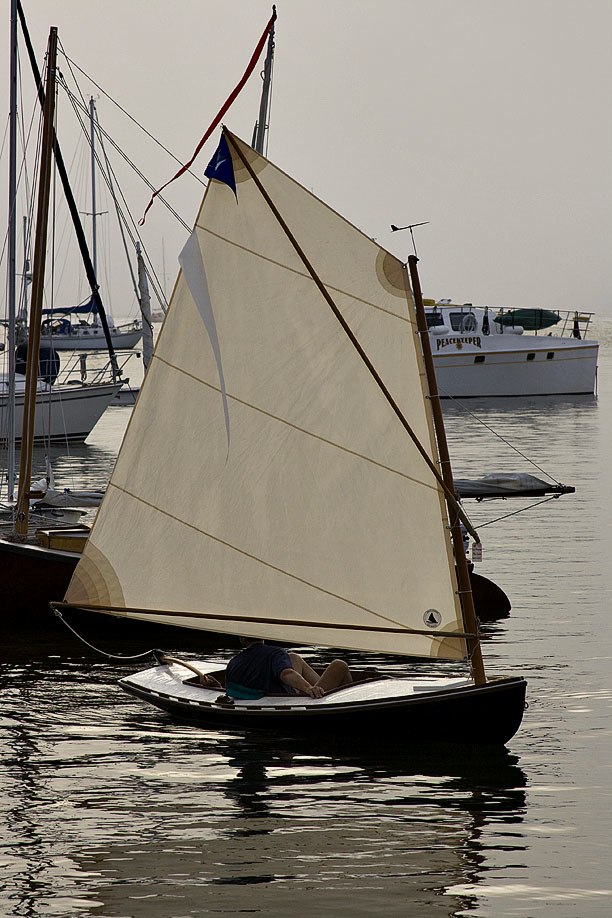 Carl Weissinger in the wooden Melonseed he built, using a Crawford rig.
Carl Weissinger in the wooden Melonseed he built, using a Crawford rig.
 A Crawford boat, still stable in a storm.
A Crawford boat, still stable in a storm.
Roger Allen, now sweltering in steamy South Florida, went to the other extreme. He designed a traditional gaff rig of 90 sq/ft to fit on a standard 13.5 foot Melonseed, specifically a Crawford boat. His plan follows the tradition of having a very large sail, with reefs that are meant to be used often. This set up produces the ultimate performance for the steady, moderate breezes of the tropics. For an experienced sailor, this is the bomb.
Roger Allen’s Gaff Plan
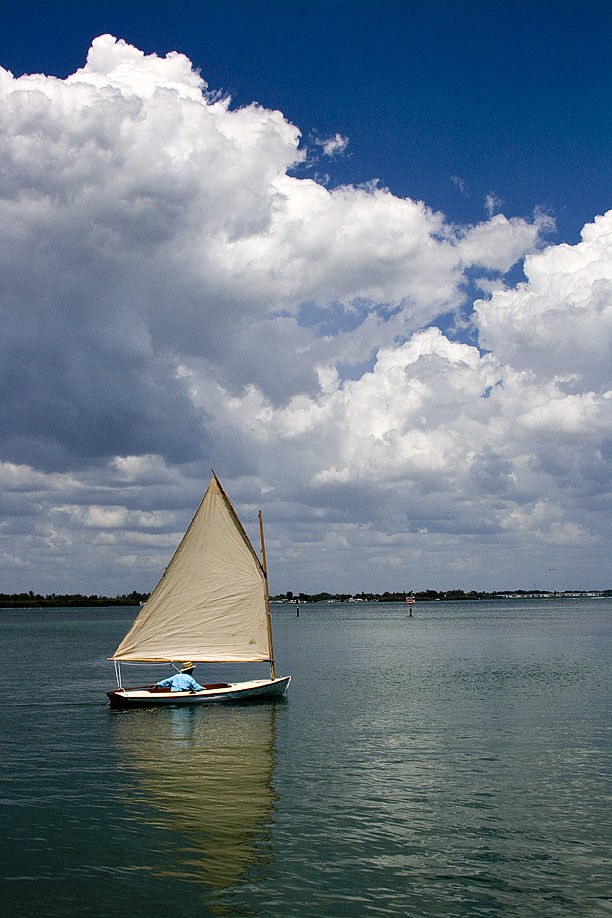 Roger Allen, sailing a Crawford boat using his 90 sq/ft gaff rig design.
Roger Allen, sailing a Crawford boat using his 90 sq/ft gaff rig design.
Roger was generous enough to send me his plans, and agreed to let me distribute them. You can download a PDF of his plans here:
MelonseedGaffSailPlan-rev3b.pdf
I have sailed in all of these boats, with all the various rigs. Deciding between them proved difficult, as they all have advantages in the conditions and for the purposes they were designed. I like the safety and simplicity of the Crawford rig. But there will be days when I will wish I had Roger Allen’s cloud of canvas. Still, I want people who are new to sailing to feel comfortable and safe at the helm. Barto’s rig seems a good compromise, but reefing a sprit sail can be problematic, and my wife, my daughters, who are not tall, (and I) may have trouble managing it while on the water. In a sudden blow that could mean trouble.
Besides all that, we don’t live on the water. It’s a two to three hour drive for us to get to good sailing grounds. That means we don’t have the luxury of simply dropping the boat in the water whenever conditions are perfect. When we get to the shore, we need to be able to adapt and sail under whatever conditions we find, because there will be no turning around and going home. That means we need a sail rig that’s adaptable.
It occurred to me a topsail is a traditional way to add more sail when winds are light. I had never seen a tops’l on a sprit rigged boat, but after doing quite a bit of digging I found some examples. The Spritsail Skiffs of North Carolina use them, and they seem to be direct descendants of the 19th Century Thames River and coastal boats of Britain.
 North Carolina Spritsail Skiff, with topsail hoisted.
North Carolina Spritsail Skiff, with topsail hoisted.
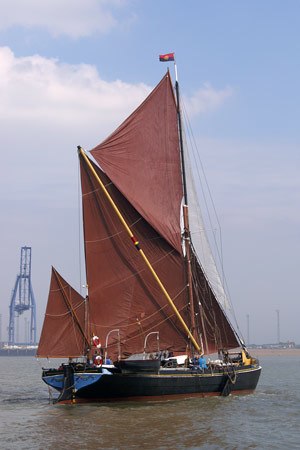 A Thames River Barge, fully canvassed.
A Thames River Barge, fully canvassed.
Ultimately, I ended up designing something traditional but different, that combines the benefits most important to me at the moment. I chose to start off with a Crawford style mainsail, with a tops’l to add when winds are light or we want more of a challenge. This will eliminate the need for reefing when using the main only. With the tops’l flying, the sail area increases by 25% to around 79 sq/ft, and does it up high where there’s more wind.
The tops’l will stay permanently lashed to the yard, which is identical in size to the other sprits. It will be raised by a halyard at the masthead, and be adjusted with an outhaul sheet attached at the peak of the sprit.
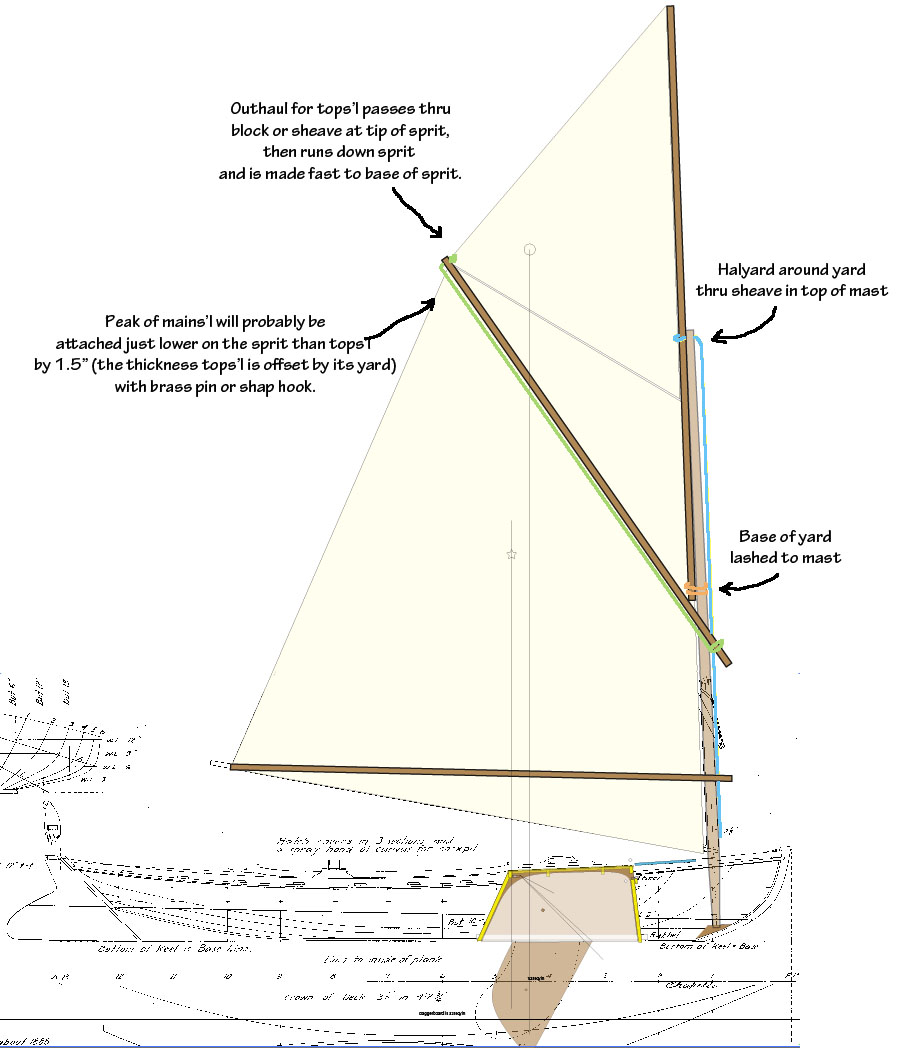
Initial sketch, with rigging diagram.
The foot of the yard will be lashed to the mast, like the Thames Barges and Carolina Skiffs. Taken down, which should be manageable on the water, the sail is reduced to the more modest 62 sq/ft. And, everything will still stow in the boat. If the tops’ls don’t work out, I reason, the worst thing that will happen is I’ll be starting out with the exact set up as over 400 Crawford boats, which isn’t too bad. And I’ll have a spare sprit.
The combined rig incorporating Dabbler’s suggestions for size and shape of tops’l.
With main and tops’l, makes about 79 sq/ft of sail.
I sent my sketch and some of these photos to Dabbler, describing what I was thinking of. He not only thought it would work, but was interested in the challenge of trying something new. A few days later, he sent me an article from Wooden Boat #157. In it, William Garden, a well known career designer of all types of watercraft, had done a tops’l for his own Peapod exactly the way I described, down to the rigging and fittings. This was all the encouragement I needed. Dabbler tweaked my drawing, and with his considerable experience modified the measurements here and there, so the concept might actually work in practice.
That was four weeks ago. Dabbler emailed me earlier this week to say they were ready. I’ve been planning to make a trip to the Northern Neck to look at a few launch sites anyway, so I arranged to drive up afterwards to Dabbler’s loft to pick them up. Terri has the day off, so we’ll do that tomorrow and make a day of it.
Right now I’m so excited I won’t be able to sleep, like a kid on Christmas Eve.
melonseed skiff, mellonseed skiff, melon seed, mellon seed
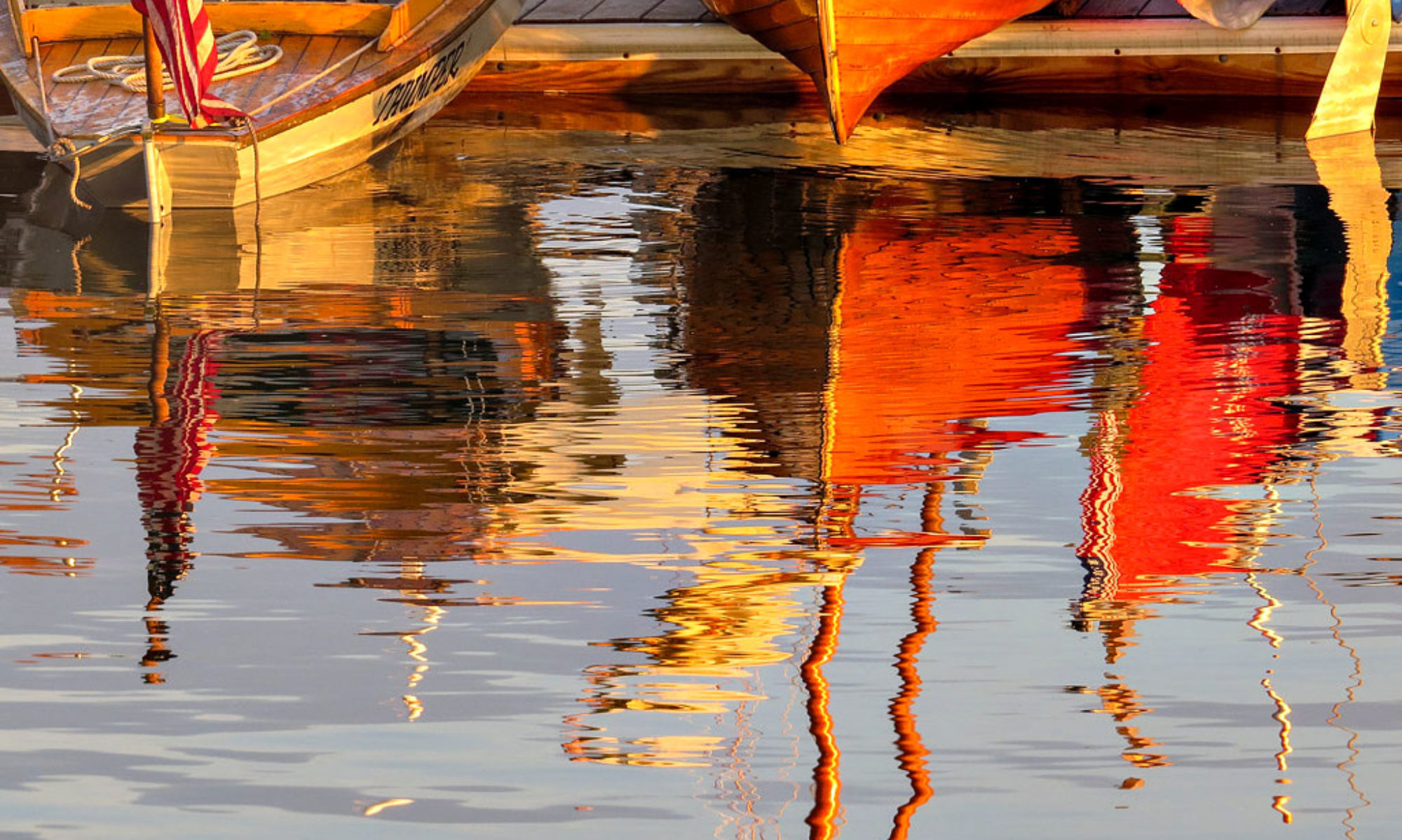



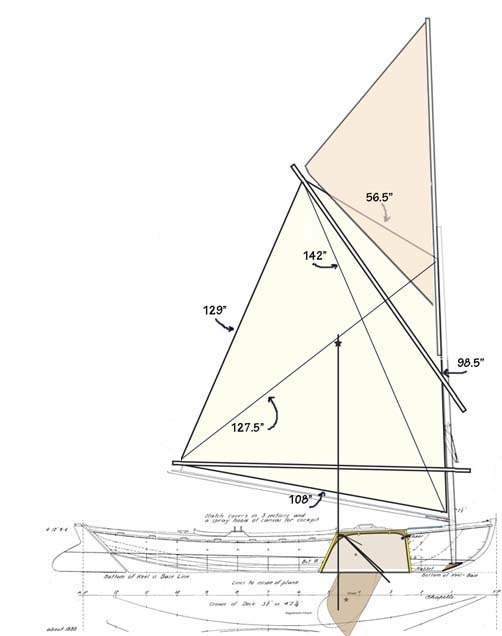
Decided to let the cat out of the bag? Can’t wait to see it in action!
-T
Sunday, May 2, 2010 – 10:48 PM
Well Tony, Dabbler has had a post up about it on his news page for about 3 weeks now, so sooner or later someone besides you would have seen it.
Besides, at this point they’re already made and ready to go. Too late to get talked out of it – all that’s left now is to actually try it! I’m pretty sure we’re only weeks away at this point.
Monday, May 3, 2010 – 12:08 AM
Barry, I can’t wait to see your sail rig. It’s absolutely unique for a melonseed. John
Saturday, May 1, 2010 – 08:45 PM
Hi John, I hope it works out well. It was talking to you, and learning how you use sails of different sizes for different conditions on your Melonseed, that started me thinking along these lines. This seemed like a way to have two different size sails on the boat at the same time.
Saturday, May 1, 2010 – 09:54 PM
read with great interest your sail modifications/addition. love to know your experience. we sail melonseed in a lake and often have light winds.
glenn
Sunday, September 19, 2010 – 11:56 AM
If you look carefully at the carolina spritsail skiff you can see some interesting points. The topsail has her own boom and the sheets go directly to the deck and do not connect at all with the main. The reason comes from stories by the oldtimers of being caught out in squalls. To shorten sail quickly they simply cut all lines to the topsail and chucked her overboard, made mental note of where she was drifting and would come back in calmer times to retrieve it. You can see spritsail skiffs in action at the North Carolina Maritime Museum or see a topsail in action on the “Spirit of Roanoke Island” at the Roanoke Island Maritime Museum.The Spirit is a shadboat which is the official state boat of Noth Carolina. I’m one of the lucky volunteers who sail her.
Sunday, February 13, 2011 – 07:18 AM
As an added comment…I’m lucky to sail the shadboat. I also did grow up on Seaford Skiffs which are cousins to the melonseed. My sister’s old skiff the “RoRo” is at Mystic Seaport. There is no finer boat for a young person to learn to sail on than these boats.
Sunday, February 13, 2011 – 07:22 AM
I’ve only seen the Shad Boat and the Spritsail Skiffs in pictures. The Mariner’s Museum has a Shad Boat in their collection in Newport News, and I even made a trip there hoping to see it, but they had it in storage. Would be great to see either of these boat types in person, and way better to actually sail in one. You are indeed lucky. I hope I can get down to NC to see them.
Interesting but effective reefing method, for sure. Presented with the same situation in a Melonseed, you would toss the whole rig overboard – topsail, mainsail, sprits and all. Can’t lower much more sail than that. And a big sea anchor, to boot.
Friday, February 18, 2011 – 12:25 PM